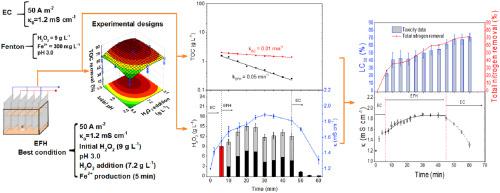Chemosphere ( IF 8.8 ) Pub Date : 2020-09-18 , DOI: 10.1016/j.chemosphere.2020.128367 Fernando Rodolfo Espinoza-Quiñones , Isabella Cristina Dall’Oglio , Aline Roberta de Pauli , Maurício Romani , Aparecido Nivaldo Módenes , Daniela Estelita Goes Trigueros

|
This work aimed to perform selective experimental arrays based on the electro-Fenton hybrid (EFH) process for pollutants abatement and toxicity reduction in brewery wastewater (BW). Fenton and electrocoagulation (EC) methods were assessed preliminarily, including the Fe2+ catalyst yield and H2O2 loss. Each method performance on reducing total organic carbon (TOC) was assessed using a 33 full factorial design (FFD). Firstly, Fe2+ species were produced in short time ranges with the electric current density at 50 A m-2 and electrical conductivity at 1200 μS cm-1, followed by EFH experiments with an initial addition of 9.0 g L-1 H2O2. In three levels, initial pH (2.5–3.5) values, Fe2+ production-dedicated time (5–15 min), and H2O2 renovating percentage (70–90%) were also evaluated, assessing TOC removal. Secondly, nine EFH kinetics, upon the addition of an initial 9.0 g L-1 H2O2 along with H2O2 addition at 82.5%, every 5 min, and three levels for pH (3.0–3.4) were carried out, beginning after three Fe2+ production-dedicated times (4–6 min). Thirdly, another 60 min kinetic experiment was proposed, with an initial 6 min EC process, followed by a 39 min EFH process, and finally, a 15 min EC process, assessing TOC removal and remaining toxicity. A significant improvement in TOC removal performance, about 90%, along with high toxicity reduction was attained after a refined EFH-based treatment. Therefore, keeping permanent EFH conditions with more suitable parameters provided a unique perspective for removing highly significant pollutants.
中文翻译:

Fenton混合工艺处理啤酒废水的见解:如何显着减少有机物和毒性
这项工作旨在执行基于电子芬顿混合(EFH)工艺的选择性实验阵列,以减少啤酒废水(BW)中的污染物并降低毒性。初步评估了Fenton和电凝(EC)方法,包括Fe 2+催化剂的得率和H 2 O 2的损失。使用3 3全因子设计(FFD)评估每种方法在减少总有机碳(TOC)方面的性能。首先,在短时间范围内产生Fe 2+物种,电流密度为50 A m -2,电导率为1200μScm -1,然后进行EFH实验,初始添加9.0 g L -1 H2 O 2。在三个级别中,还评估了初始pH(2.5–3.5)值,Fe 2+生产专用时间(5–15分钟)和H 2 O 2更新百分比(70–90%),从而评估了TOC去除率。第二,每5分钟添加9份EFH动力学,同时添加最初的9.0 g L -1 H 2 O 2和82.5%的H 2 O 2,并进行三个pH值(3.0-3.4)的测试, 3 Fe 2+之后开始生产专用时间(4–6分钟)。第三,提出了另一个60分钟的动力学实验,首先是6分钟的EC过程,然后是39分钟的EFH过程,最后是15分钟的EC过程,以评估TOC的去除和残留毒性。经过精制的基于EFH的处理后,TOC去除性能有了显着改善(约90%),并且毒性大大降低。因此,将永久性EFH条件与更合适的参数保持在一起,为去除高度重要的污染物提供了独特的视角。

























 京公网安备 11010802027423号
京公网安备 11010802027423号